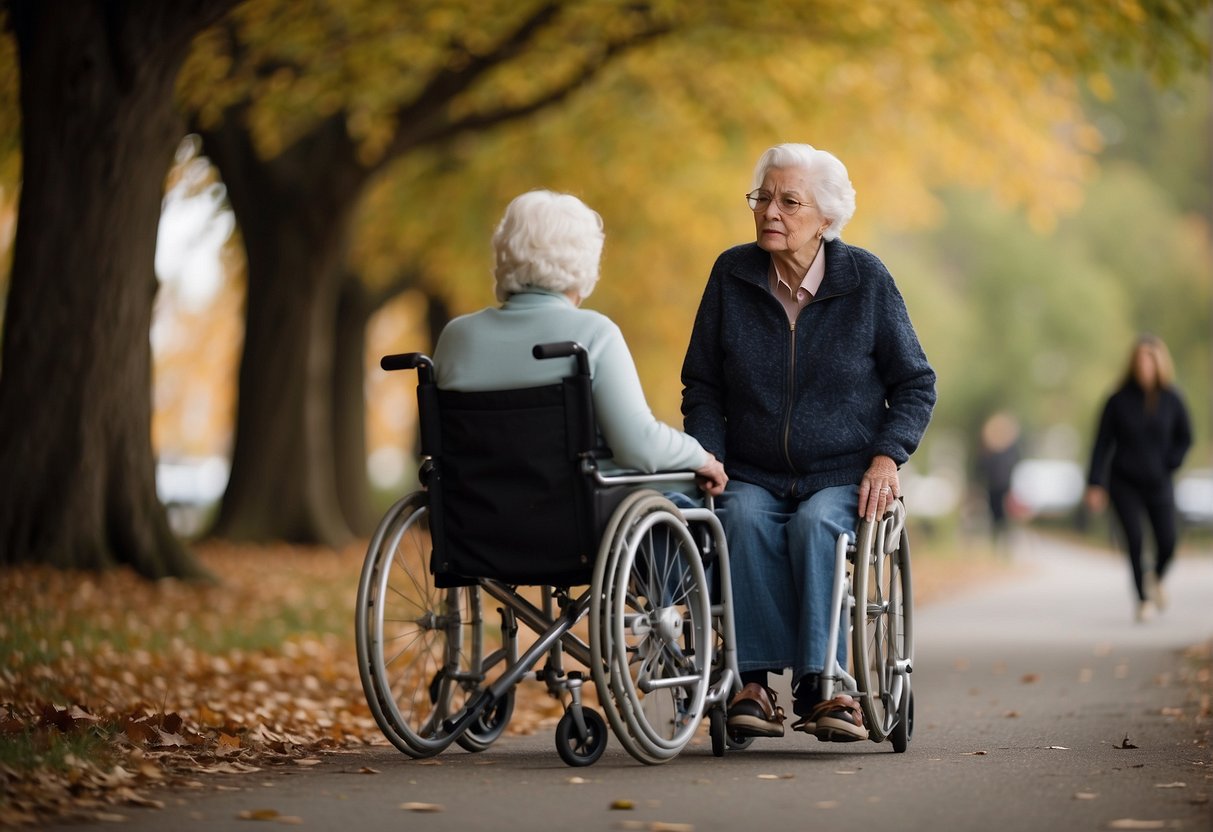Understanding Nursing Home Abuse

Nursing home abuse is a serious violation that affects the well-being of elderly individuals. We will define abuse and neglect, identify signs of abuse, and discuss its prevalence and risk factors.
Defining Abuse and Neglect
Abuse in nursing homes is the mistreatment of residents, who are often vulnerable due to age or disability. It can take multiple forms:
- Physical abuse involves causing bodily harm or pain.
- Sexual abuse includes any non-consensual sexual contact.
- Psychological abuse refers to verbal or non-verbal actions causing mental anguish.
- Financial abuse is the unauthorized use of a resident’s funds or assets.
- Emotional abuse entails actions that create emotional pain or distress.
Neglect is the failure to provide essential care, resulting in harm to the resident. It may manifest as inadequate hygiene, nutrition, or medical attention.
Recognizing the Signs of Abuse
We must be vigilant in identifying potential abuse. Signs of abuse may include, but are not limited to:
- Unexplained injuries or frequent hospital visits
- Sudden changes in behavior or mood
- Withdrawal from social interactions
- Unusual financial transactions
It’s crucial to listen to residents’ concerns and observations, as they are often reliable indicators of their lived experiences.
Prevalence and Risk Factors
Abuse in nursing homes is unfortunately more common than we would like to think. Factors that increase risk include:
- Staffing shortages that lead to neglect
- Inadequate employee screening
- Lack of proper training for staff
- Isolation of residents, which can make them more susceptible to abuse
Understanding these risk factors helps us to implement ways to prevent abuse and protect our elderly from harm.
Legal Rights and Protections
In this section, we’ll cover the essential legal structures that defend the rights of elderly individuals in nursing homes, ensuring their right to privacy, respect, and protection under federal and state laws.
Federal and State Regulations
Federal and state regulations are pivotal in safeguarding the rights and welfare of nursing home residents. Federal law stipulates baseline standards of care, which states can supplement with their regulations. These laws are enforced by multiple agencies, including the Department of Justice and state health departments, working in coordination to curb elder abuse and neglect. Regular inspections and investigations help maintain compliance and are critical tools in law enforcement’s effort to protect the elderly.
The Nursing Home Reform Act
The Nursing Home Reform Act (NHRA) of 1987 is a cornerstone in federal legislation, enshrining the right to receive quality care without abuse, neglect, or mistreatment. The Act establishes the following rights, among others:
- Right to Privacy: each resident’s right to personal and healthcare privacy.
- Right to be Treated with Respect: treatment that honors each resident’s dignity and individuality.
- Freedom from Abuse and Neglect: stringent measures against any form of abuse, whether physical, emotional, or sexual.
- Right to be Fully Informed of One’s Medical Condition and to Refuse Treatment: empowering residents through informed consent.
Resident Rights and Facility Accountability
We recognize that a robust legal framework must ensure the enforcement of resident rights and accountability of nursing homes. Residents possess the right to:
- Be fully informed of services and charges.
- Voice grievances without discrimination or reprisal.
Nursing homes are held accountable through mandatory reporting of incidents, accessibility of records to residents, and penalties for non-compliance. Regular surveys and certification processes validate adherence to regulations and the upholding of resident rights.
Facilities that fail to comply with federal and state standards may face consequences, such as fines, denial of payment from federal funds, and potential closure. Law enforcement and the Department of Justice are crucial in investigating allegations and prosecuting cases of elder abuse and neglect, ensuring justice and adherence to legal rights.
Reporting and Investigating Abuse
In protecting the rights of elderly individuals, it’s vital to understand the procedures for reporting suspected nursing home abuse and the subsequent investigation processes. Each report triggers a complex system of oversight and accountability designed to safeguard vulnerable residents.
How and Where to Report Abuse
When abuse is suspected, we can report it to several entities, primarily the Department of Health and Human Services (HHS) and the Centers for Medicare & Medicaid Services (CMS). Reports should be detailed, including:
- Who was involved: name(s) of the victim(s) and any potential witness(es)
- What happened: a clear description of the incident(s)
- Where the abuse occurred: the specific location within the facility
- When the abuse took place: dates and times, if known
- Why the reporter suspects abuse: any signs, symptoms, or evidence
- How the abuse occurred: any known methods or tactics used by the perpetrator(s)
Reports can be made through several channels:
- Phone Hotlines: often provided by state health departments
- Online Portals: offered by state or federal agencies for electronic submission
- Mail: sending a written complaint directly to the appropriate agency
- In-Person: speaking directly to a staff member, if reporting internally within the facility
The Role of Ombudsmen and Law Enforcement
The Long-Term Care Ombudsman Program plays a key role in advocating for residents’ rights. These ombudsmen are responsible for:
- Investigating complaints made by or on behalf of the residents.
- Providing oversight to ensure proper resolution and accountability.
Law enforcement agencies get involved when there’s suspected criminal activity. Their collaboration with ombudsmen and health agencies ensures comprehensive investigations.
Investigative Processes and Challenges
Once a report is made, a multifaceted investigation begins, typically conducted by the HHS or state public health departments. The process includes:
- Initial review of the report to determine if the complaint warrants further investigation.
- Onsite investigations, where officials visit the nursing home to gather evidence, interview witnesses, and review records.
Investigators navigate various challenges, including:
- Limited cooperation from facility staff or residents.
- Manipulation of records or evidence.
- Distinguishing between accidents and intentional harm.
Ultimately, an effective investigation hinges on thoroughness and impartiality to uphold justice and protect the rights of elderly individuals.
Preventive Measures and Best Practices
To ensure the safety and well-being of elderly individuals in nursing homes, we prioritize a combination of comprehensive training, the creation of secure and respectful environments, and the implementation of thorough care policies.
Training and Education for Caregivers
We recognize that continuous education and training for caregivers are fundamental to preventing abuse and enhancing the quality of life for residents. Our efforts include:
- Mandatory Orientation: New staff attend an orientation program detailing our standards of care and respect for residents.
- Ongoing Training Modules: Periodic workshops on updated care techniques and legal requirements related to elder care.
Creating a Safe and Respectful Environment
By fostering a culture of dignity and respect, we curtail the risk of nursing home abuse. Key steps include:
- Zero-Tolerance Policy: Clear communication of non-negotiable standards against any form of abuse.
- Regular Assessments: Routine evaluations of the living environment to ensure safety compliance and identify improvement areas.
Implementing Comprehensive Care Policies
Our commitment to preventing any form of elder mistreatment is reflected in our comprehensive care policies. These include:
- Personalized Care Plans: Development of individualized service plans that detail the specific needs and activities beneficial for each resident.
- Proactive Interventions: Implementation of targeted interventions designed to recognize and address potential issues before they escalate.
Support and Resources for Families
We understand that ensuring the well-being of our elderly loved ones involves not only selecting the best possible care facility but also staying well-informed and connected with support systems. Here we discuss the resources available to help us protect their rights and dignity.
Choosing the Right Care Facility
When selecting a long-term care facility, it’s crucial to research whether they accept Medicaid or Medicare, as these can vastly influence our financial planning. We must look for facilities with robust elderly care programs and a history of compliance with care standards. The Medicare Nursing Home Compare tool is an excellent resource to assess care facilities’ quality.
- List of amenities and services
- Staff-to-resident ratio
- Compliance with health and safety regulations
Working with Facility Administrators
Constructive engagement with care facility administrators is key in monitoring and ensuring quality care. We must familiarize ourselves with the facility’s policies and communicate our concerns promptly. In case of disputes, resources like the Ombudsman program provide a mediated pathway to resolve issues.
- Regular meetings with staff
- Clear communication channels
- Escalation protocols
Support Groups and Advocacy Organizations
Joining support groups and connecting with advocacy organizations can provide us comfort and practical assistance. Organizations such as the National Center on Elder Abuse (NCEA) offer valuable resources and community support networks. They help us navigate the complexities of long-term care in assisted living facilities and other community settings.
- National Center on Elder Abuse (NCEA)
- Local support groups for families
- Online forums for sharing experiences and advice
By harnessing these resources, we can better safeguard the rights and interests of our elderly family members in various care settings.
Frequently Asked Questions
In this section, we address common concerns regarding elder abuse in nursing homes to help you recognize, report, and prevent mistreatment and uphold the rights of the elderly.
What are the signs of elder abuse in nursing homes?
Recognizing elder abuse requires vigilance. Look for physical signs such as bruises, bedsores, and unexplained weight loss, as well as emotional symptoms like withdrawal, anxiety, or fear around caregivers.
How can one report suspected abuse in a long-term care facility?
If you suspect abuse, it is imperative to act promptly. Report your concerns to the facility’s management, local adult protective services, or law enforcement. In emergency situations, call 911 immediately.
What legal actions can be taken against nursing home abuse?
Legal recourse for nursing home abuse can include filing a report with the state’s regulatory agency, pursuing a civil lawsuit for damages, or criminal charges if the abuse constitutes a violation of the law.
How can nursing home abuse be prevented?
Preventing abuse involves several strategies including thorough staff vetting, proper training in elder care, establishing strict policies on resident treatment, regular monitoring of resident wellbeing, and encouraging open communication with residents and their families.
What are the psychological and physical effects of abuse on elderly residents in care homes?
Abuse can lead to severe psychological issues such as depression, anxiety, and post-traumatic stress, alongside physical effects that range from persistent pain to increased risk of chronic conditions and a decreased quality of life.
What responsibilities do staff members have in preventing resident-to-resident abuse in nursing homes?
Staff members must foster a safe environment through supervision, enforcing rules against bullying and violence, immediately addressing conflicts, and providing support to those involved. Training on recognizing signs of aggression and intervening effectively is essential.




